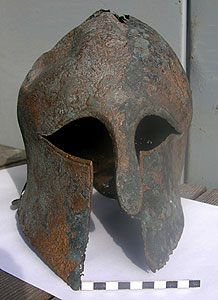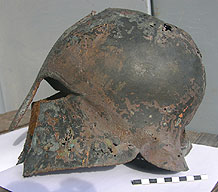A helmet of a Greek warrior of the 6th-5th century BCE was discovered (April 19, 2007)

A helmet of a Greek warrior of the 6th-5th century BCE was discovered on the seabed in Haifa harbor. The front of the helmet is decorated with a pattern of engravings and hammering that depicts a peacock’s tail above the nose guard and forehead and a snake decoration above the eye slits.
The cheek guards were decorated with a lion motif. This is the most complete helmet to be discovered to date on the coast of Israel.
During the course of dredging Haifa harbor by a Dutch excavation ship, on behalf of the Aronson Company, a bronze helmet, in an excellent state of preservation, was found. The helmet was handed over by the ship’s owner, Mr. Hugo van de Graaf, with the assistance of Sarah Aronson, to the Marine Unit of the Antiquities Authority. The Corinthian type helmet (named after the city of Corinth where it was first developed and produced in the 6th century BCE and from which it was distributed throughout the Mediterranean basin), was fabricated by experts from a single sheet of bronze by means of heating and hammering. This technique made it possible to reduce the weight of the helmet without diminishing its capacity to protect the head of the warrior. The front of the helmet (the nose and cheek guards) is thicker than its back. The front, above the nose guard and the forehead, is adorned with an engraved and hammered decoration of a peacock’s tail and snakes are incised above the eye slits. The cheek guards are decorated with a pattern of lions, one on the right side and one on the left.

Kobi Sharvit, director of the Marine Unit of the Antiquities Authority, reports that, “the helmet that was recovered from the seabed in Haifa harbor is the most complete example to be discovered to date on the coast of Israel”. According to Sharvit, the helmet probably belonged to a Greek warrior stationed on one of the warships of the Greek fleet that participated in the naval conflict against the Persians who ruled the country at the time. However, the helmet was probably that of a mercenary who was aboard a ship that traded with the nearby coastal settlement at Tell Abu Hawam, near the outlet of Nahal Kishon. In excavations that were conducted at Tell Abu Hawam in 1932-1933 pottery vessels were found had been imported from Corinth. In the excavations that were carried out there in recent years, on behalf of the University of Haifa and the Antiquities Authority, archaeological strata of a well-planned city were exposed which yielded a large quantity of Greek vessels.
Additional Articles ...
Archive